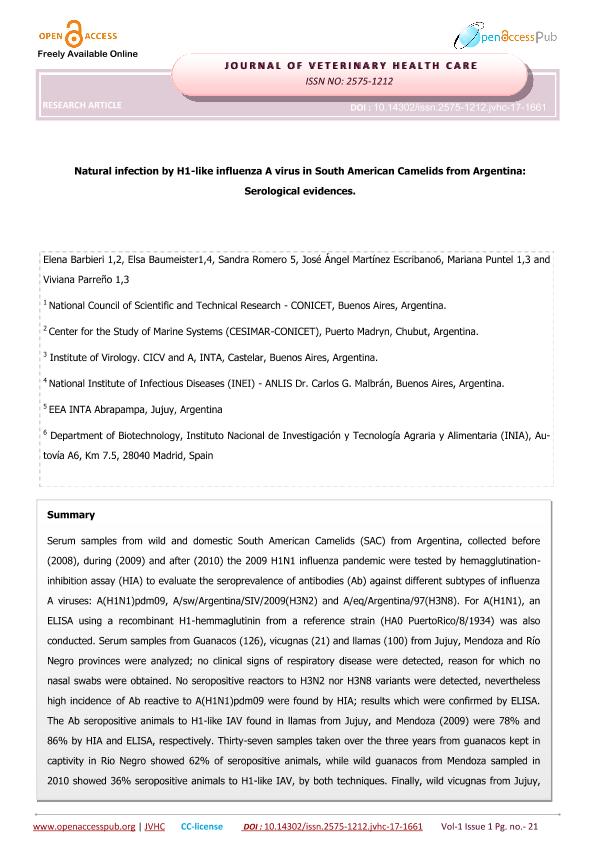Mostrar el registro sencillo del ítem
dc.contributor.author
Barbieri, Elena Susana

dc.contributor.author
Baumeister, Elsa

dc.contributor.author
Romero, Sandra

dc.contributor.author
Martínez Escribano , José Ángel
dc.contributor.author
Puntel, Mariana

dc.contributor.author
Parreño, Gladys Viviana

dc.date.available
2019-05-02T19:11:41Z
dc.date.issued
2017-07
dc.identifier.citation
Barbieri, Elena Susana; Baumeister, Elsa; Romero, Sandra; Martínez Escribano , José Ángel; Puntel, Mariana; et al.; Natural infection by H1-like influenza A virus in South American Camelids from Argentina: Serological evidences; Open access pub; Journal of Veterinary Healthcare; 1; 1; 7-2017; 21-38
dc.identifier.issn
2575-1212
dc.identifier.uri
http://hdl.handle.net/11336/75438
dc.description.abstract
Serum samples from wild and domestic South American Camelids (SAC) from Argentina, collected before (2008), during (2009) and after (2010) the 2009 H1N1 influenza pandemic were tested by hemagglutinationinhibition assay (HIA) to evaluate the seroprevalence of antibodies (Ab) against different subtypes of influenza A viruses: A(H1N1)pdm09, A/sw/Argentina/SIV/2009(H3N2) and A/eq/Argentina/97(H3N8). For A(H1N1), an ELISA using a recombinant H1-hemmaglutinin from a reference strain (HA0 PuertoRico/8/1934) was also conducted. Serum samples from Guanacos (126), vicugnas (21) and llamas (100) from Jujuy, Mendoza and Río Negro provinces were analyzed; no clinical signs of respiratory disease were detected, reason for which no nasal swabs were obtained. No seropositive reactors to H3N2 nor H3N8 variants were detected, nevertheless high incidence of Ab reactive to A(H1N1)pdm09 were found by HIA; results which were confirmed by ELISA.The Ab seropositive animals to H1-like IAV found in llamas from Jujuy, and Mendoza (2009) were 78% and 86% by HIA and ELISA, respectively. Thirty-seven samples taken over the three years from guanacos kept in captivity in Rio Negro showed 62% of seropositive animals, while wild guanacos from Mendoza sampled in 2010 showed 36% seropositive animals to H1-like IAV, by both techniques. Finally, wild vicugnas from Jujuy, sampled in 2008 showed 38% and 52% seropositive animals to H1-like IAV by HIA and ELISA, respectively. Our results could indicate the potential role of these species as a reservoir of this zoonotic viral agent of high impact in Public Health, and may suggest that SAC populations might have been infected with an influenza strain antigenically related to H1 IAV. . Surprisingly, for llama and guanaco populations sampled over time in Jujuy and Río Negro, respectively, the HIA and ELISA geometric mean Ab titers (GMT) for 2008 were significantly higher than the ones of 2010. In addition, HIA and ELISA Ab titers found in domestic llamas were significantly higher than those detected in wild vicugnas sampled during that year (2008) in Jujuy. New field campaigns are in progress to collect serum samples and nasal swabs in order to isolate and characterize the virus responsible for triggering H1 reactive Abs. These findings remark the need to better understand the dynamics and ecology of influenza A virus within Sacs populations.
dc.format
application/pdf
dc.language.iso
eng
dc.publisher
Open access pub
dc.rights
info:eu-repo/semantics/openAccess
dc.rights.uri
https://creativecommons.org/licenses/by-nc-sa/2.5/ar/
dc.subject
Influenza Virus H1n1
dc.subject
Sudamerican Camelids
dc.subject
Seroprevalence
dc.subject
Epidemiology
dc.subject.classification
Otras Ciencias Veterinarias

dc.subject.classification
Ciencias Veterinarias

dc.subject.classification
CIENCIAS AGRÍCOLAS

dc.title
Natural infection by H1-like influenza A virus in South American Camelids from Argentina: Serological evidences
dc.type
info:eu-repo/semantics/article
dc.type
info:ar-repo/semantics/artículo
dc.type
info:eu-repo/semantics/publishedVersion
dc.date.updated
2019-05-02T18:12:13Z
dc.journal.volume
1
dc.journal.number
1
dc.journal.pagination
21-38
dc.journal.pais
Sudáfrica

dc.journal.ciudad
Durban
dc.description.fil
Fil: Barbieri, Elena Susana. Consejo Nacional de Investigaciones Científicas y Técnicas. Centro Científico Tecnológico Conicet - Centro Nacional Patagónico. Centro para el Estudio de Sistemas Marinos; Argentina
dc.description.fil
Fil: Baumeister, Elsa. Consejo Nacional de Investigaciones Científicas y Técnicas; Argentina. Dirección Nacional de Instituto de Investigación. Administración Nacional de Laboratorio e Instituto de Salud “Dr. C. G. Malbrán”; Argentina
dc.description.fil
Fil: Romero, Sandra. Instituto Nacional de Tecnología Agropecuaria; Argentina
dc.description.fil
Fil: Martínez Escribano , José Ángel. Instituto Nacional de Investigación y Tecnología Agraria y Alimentaria; España
dc.description.fil
Fil: Puntel, Mariana. Consejo Nacional de Investigaciones Científicas y Técnicas; Argentina. Instituto Nacional de Tecnología Agropecuaria. Centro de Investigación en Ciencias Veterinarias y Agronómicas; Argentina
dc.description.fil
Fil: Parreño, Gladys Viviana. Consejo Nacional de Investigaciones Científicas y Técnicas; Argentina. Instituto Nacional de Tecnología Agropecuaria. Centro de Investigación en Ciencias Veterinarias y Agronómicas; Argentina
dc.journal.title
Journal of Veterinary Healthcare
dc.relation.alternativeid
info:eu-repo/semantics/altIdentifier/doi/https://dx.doi.org/10.14302/issn.2575-1212.jvhc-17-1661
dc.relation.alternativeid
info:eu-repo/semantics/altIdentifier/url/https://openaccesspub.org/jvhc/article/565
Archivos asociados
